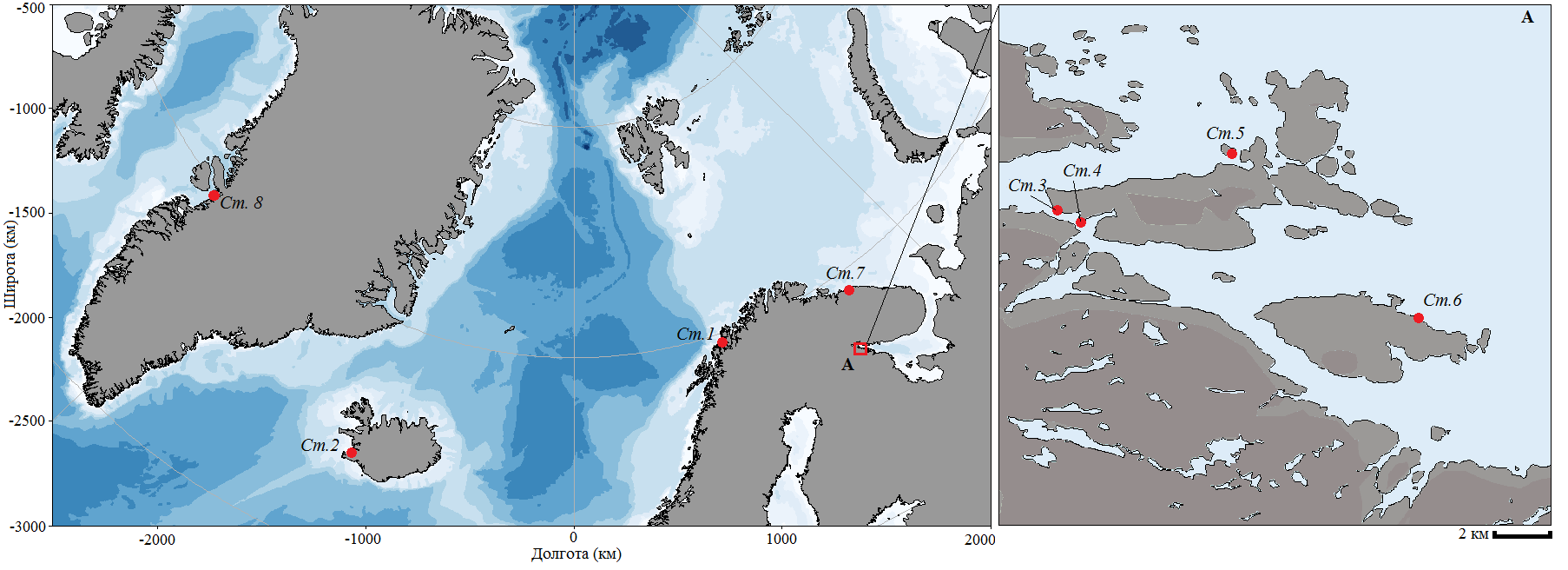COMPARATIVE STUDY OF POLYPHENOLS OF BROWN ALGAE OF THE BARENTS SEA AND THE WHITE SEA, AS WELL AS THE WATERS OF THE NORTH ATLANTIC
UDC 542.06+577.1
Abstract
The polyphenol content in the brown algae of the Barents, White Seas, as well as the water areas of the Northwest Atlantic (the Norwegian Sea, the Faxflow bay of the Atlantic Ocean) located in Russia, Norway, Greenland, and Iceland are compared. Algae of the following species were used for this study: Fucus vesiculosus, Fucus spiralis, Fucus serratus, Ascophyllum nodosum, Fucus evanescens. It was found that the most productive raw materials for the extraction of polyphenolic compounds are brown algae F. vesiculosus, growing in Zavalishin Bay of the Barents Sea (Russia): the highest polyphenol content (14.4%) in the summer of 2019 was noted here. Polyphenols detected in F. vesiculosus in the summer from the White Sea on about. Great burnt (13.3%) (Russia), as well as in the Norwegian Sea, Cape Sydspissen (11.6%) (Norway). The minimum content of polyphenols was found in F. spiralis (0.7% dry mass) on the coast of Iceland (Faxflow bay), a low content of polyphenols was characteristic of all types of algae from this location (0.7–2.4%). Three-way analysis of variance (MANOVA) on the example of three types of algae (F. vesiculosus, F. spiralis, A. nodosum) showed that all the studied factors (place of collection, type of algae, fertile phase) are significant. The most significant factor affecting the accumulation of polyphenols by brown algae is the location of algae growth.
The high content of polyphenols in the types of algae we studied from Russian water areas allows us to recommend their use as food and medicinal raw materials, as well as raw materials for biologically active additives.
Downloads
Metrics
References
Imbs T.I., Zvyagintseva T.N. Biologiya moray, 2018, vol. 44, no. 4, pp. 217–227. DOI: 10.1134/S0134347518040010. (in Russ.).
Bogolitsyn K.G., Druzhinina A.S., Ovchinnikov D.V., Kaplitsin P.A., Shul'gina Ye.V., Parshina A.E. Khimiya Ras-titel'nogo Syr'ya, 2018, no. 3, pp. 5–21. DOI: 10.14258/jcprm.2018031898. (in Russ.).
Li Y.X., Wijesekara I., Li Y., Kim S.-K. Process biochemistry, 2011, vol. 46, no. 12, pp. 2219–2224. DOI:10.1016/j.procbio.2011.09.015.
Bogolitsyn K.G., Druzhinina A.S., Ovchinnikov D.V., Parshina A.E., Shul'gina Ye.V., Turova P.N., Stavrianidi A.N. Khimiya Rastitel'nogo Syr'ya, 2019, no. 4, pp. 65–75. DOI: 10.14258/jcprm.2019045135. (in Russ.).
Wang T., Jónsdóttir R., Liu H., Gu L., Kristinsson H.G., Raghavan S., Olafsdóttir G. Agricultural and food chemistry, 2012, vol. 60, pp. 5874–5883. DOI: 10.1021/jf3003653.
Klindukh M.P., Obluchinskaya E.D. Vestnik MGTU, 2013, vol. 16, no. 3, pp. 466–471. (in Russ.).
Ragan M.A., Jensen A. Journal of Experimental Marine Biology and Ecology, 1978, vol. 34, pp. 245–258. DOI: 10.1016/S0022-0981(78)80006-9.
Parys S., Kehraus S., Pete R., Kupper F.C., Glombitza K.W., Konig G.M. European Journal of Phycology, 2009, vol. 44, no. 3, pp. 331–338. DOI: 10.1080/09670260802578542.
Ronnberg O., Ruokolahti C. Ann. Bot. Fennici, 1986, vol. 23, pp. 317–323.
Svensson C.J., Pavia H., Toth G.B. Mar. Biol., 2007, vol. 151, pp. 2177–2188. DOI: 10.1007/s00227-007-0649-5.
Tkach A.V., Obluchinskaya Ye.D. Vestnik Murmanskogo gosudarstvennogo tekhnicheskogo universiteta, 2017, vol. 20, no. 2, pp. 326–335. DOI: 10.21443/1560-9278-2017-20-2-326-335(in Russ.).
Gosudarstvennyy doklad «O sostoyanii i ob okhrane okruzhayushchey sredy Rossiyskoy Federatsii v 2013 godu» [State report "On the state and protection of the environment of the Russian Federation in 2013"] URL: http://www.ecogosdoklad.ru/2013/wwwBio1_4_5.aspx (in Russ.).
Shikov A.N., Tsitsilin A.N., Pozharitskaya O.N., Makarov V.G., Heinrich M. Frontiers in Pharmacology, 2017, vol. 8, article 841. DOI: 10.3389/fphar.2017.00841.
Van Alstyne K.L. Journal of Chemical Ecology, 1995, vol. 21, pp. 45–58. DOI: 10.1007/BF02033661.
Koivikko R., Loponen J., Pihlaja K., Jormalainen V. Phytochemical Analysis, 2007, vol. 18, pp. 326–332. DOI: 10.1002/pca.986
Holdt S.L., Kraan S. J. Appl. Phycol., 2011, vol. 23, pp. 543–597. DOI: 10.1007/s10811-010-9632-5.
Moreira R., Chenlo F., Sineiro J., Arufe S., Sexto S. Appl. Phycol., 2016, vol. 28, pp. 2485–2494. DOI: 10.1007/s10811-015-0744-9.
Ford L., Theodoridou K., Sheldrake G.N., Walsh P.J. Phytochemical Analysis, 2019, vol. 30, no. 6, pp. 587–599. DOI: 10.3390/antiox8120612.
Aminina N.M. Izvestiya TINRO, 2015, vol. 182, pp. 258–268. DOI: 10.26428/1606-9919-2015-182-258-268. (in Russ.).
Shoshina E.V., Kapkov V.I. Vestnik Murmanskogo gosudarstvennogo tekhnicheskogo universiteta, 2014, vol. 17, no. 1, pp. 180–189. (in Russ.).
Kyung-Tae К. Seasonal variation of seaweed components and novel biological function of fucoidan extracted from brown algae in Quebec: diss. …PhD. Quebec, 2012, 142 p.
Farvin K.H.S., Jacobsen C. Food Chemistry, 2013, vol. 138, pp. 1670–1681. DOI: 10.1016/j.foodchem.2012.10.078.
Kim S.M., Kang S.W., Jeon J.-S., Jung Y.-J., Kim W.-R., Kim C.Y., Um B.-H. Food Chemistry, 2013, vol. 138, pp. 2399–2406. DOI: 10.1016/j.foodchem.2012.11.057.
Shibneva S.Yu., Skriptsova A.V. Biologiya moray, 2015, vol. 41, no. 5, pp. 301–311. (in Russ.).

Copyright (c) 2020 chemistry of plant raw material

This work is licensed under a Creative Commons Attribution 4.0 International License.

This work is licensed under a Creative Commons Attribution 4.0 International License.
The authors, which are published in this journal, agree to the following conditions:
1. Authors retain the copyright to the work and transfer to the journal the right of the first publication along with the work, at the same time licensing it under the terms of the Creative Commons Attribution License, which allows others to distribute this work with the obligatory indication of the authorship of this work and a link to the original publication in this journal .
2. The authors retain the right to enter into separate, additional contractual agreements for the non-exclusive distribution of the version of the work published by this journal (for example, to place it in the university depository or to publish it in a book), with reference to the original publication in this journal.
3. Authors are allowed to post their work on the Internet (for example, in a university repository or on their personal website) before and during the review process of this journal, as this may lead to a productive discussion, as well as more links to this published work.











